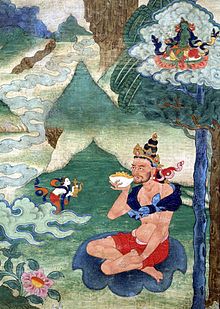নারো পা

নারো পা বা নারোপাদ[১] বা নড়পাদ[২] (১০১৬–১১০০)[৩][৪] একজন ভারতীয় বৌদ্ধ মহাসিদ্ধ ছিলেন।
নাম
[সম্পাদনা]গ্যুসেপ তুচ্চি একটি সংস্কৃত পুঁথি সম্পাদনা করতে গিয়ে প্রাকৃত শব্দ নারো পা এবং একটি সংস্কৃত ঘেঁষা শব্দ নারোপাদ খুঁজে পান। পরমার্থসংগ্রহ নামক একটি সংস্কৃত পুঁথিতে নড়পাদ নামক শব্দটি পাওয়া যায়। তিব্বতীরা তাদের ভাষায় তার নাম না-রো-পা, না-রো-পান-ছেন, না-রো-তা-পা প্রভৃতি রাখেন।[৫]
জীবনী
[সম্পাদনা]নারোপা একটি ব্রাহ্মণ পরিবারে জন্মগ্রহণ করেন। পিতার মাতার ইচ্ছাতে তিনি এক ব্রাহ্মণ কন্যাকে বিবাহ করতে বাধ্য হলেও আট বছর বিবাহিত জীবনের পর তিনি বৌদ্ধ ধর্ম গ্রহণ করে ২৮ বছর বয়সে নালন্দা বিশ্ববিদ্যালয়ে সূত্র ও তন্ত্র শিক্ষার জন্য ভর্তি হন। এরপর তিনি মহাসিদ্ধ তিলো পার নিকটে গিয়ে বারো বছর ধরে মহামুদ্রা তত্ত্ব শিক্ষালাভ করেন। নারো পা তার শিক্ষা তিব্বতী অনুবাদক তথা বৌদ্ধ পণ্ডিত মার-পা-ছোস-ক্যি-ব্লো-গ্রোসকে দিয়ে যান।[৬]:১৪৪-১৪৭ এই বৌদ্ধ পণ্ডিত ফুল্লহারী নামক স্থানে[n ১] তার শেষ জীবন অতিবাহিত করে ৮৫ বছর বয়সে মারা যান।
স্বীকৃতি
[সম্পাদনা]তিব্বতী বৌদ্ধধর্মের কাগ্যু ধর্মসম্প্রদায় নারো পাকে এক গুরুত্বপূর্ণ শিক্ষক হিসেবে মনে করে। তাদের মতে, তিলো পার কাছ থেকে নারো পা ছয়টি যোগ সম্বন্ধে জ্ঞানলাভ করে হয়ে তার ছাত্র মার-পা-ছোস-ক্যি-ব্লো-গ্রোসকে দান করেন যা র্জে-ব্ত্সুন-মি-লা-রাস-পার মাধ্যমে তিব্বতীদের কাছে পৌছয়। নারো পাকে চুরাশি মহাসিদ্ধদের মধ্যে একজন বলেও বর্ণনা করা হয়ে থাকে।
আরও পড়ুন
[সম্পাদনা]- The Life and Teaching of Naropa by Herbert V Gunther. Shambhala Publications 1999 Massachusetts. আইএসবিএন ১-৫৬৯৫৭-১১০-৪
- The Life of Marpa the Translator, Seeing Accomplishes All. Tsang Nyon Heruka Translated by the Nalanda Translation Committee. Shambhala Publications 1995 Boston. আইএসবিএন ১-৫৭০৬২-০৮৭-৩ (pbk.)
- The Life Story of Naropa by Kenpo Chodrak Rinpoche. Published in Kagyu Life International No's 3 & 4,1995 San Francisco.
- The Golden Kagyu Garland, A History of the Kagyu Lineage, adapted by Bruce Tarver. Published in Buddhism Today Issue 15, 2005
- 2nd Dalai Lama. Tantric Yogas of Sister Niguma, Snow Lion Publications, 1st ed. U. edition (May 1985), আইএসবিএন ০-৯৩৭৯৩৮-২৮-৯ (10), আইএসবিএন ৯৭৮-০-৯৩৭৯৩৮-২৮-৭ (13)
- Naropa by Satyananda Giri. Strategic Publishing Group, 2011. আইএসবিএন ৯৭৮-১-৬১২০৪-৪৪৮-৪
পাদটীকা
[সম্পাদনা]- ↑ Because I went alone as an insignificant monk to see the Lord Atisha —— and because he tarried for a year in Magadha — I thought I would go see the Lord Naropa, since his reputation was so great. I went east from Magadha for a month, as I had heard that the Lord was staying in the monastery known as Phullahari. Very great merit arose from being able to go see him. On the day I arrived, they said some feudal prince had come to pay homage. So I went to the spot, and a great throne had been erected. I sat right in front of it. The whole crowd started buzzing, "The Lord is coming!" I looked and the Lord was physically quite corpulent, with his white hair [stained with henna] bright red, and a vermilion turban on. He was being carried [on a palanquin] by four men, and was chewing betelleaf. I grabbed his feet and thought, "I should listen to his pronoucements!" Stronger and stronger people, though, pushed me further and further from his feet and finally I was tossed out of the crowd. So, there I saw the Lord's face, but did not actually hear his voice.[৬]:৩১৭
তথ্যসূত্র
[সম্পাদনা]- ↑ Encyclopedia of Asian Philosophy ed. Oliver Leaman. Routledge: 2001. আইএসবিএন ০-৪১৫-১৭২৮১-০ pg 282
- ↑ "Notes on the Origin of Some Quotations in the Sekoddeśaṭīkā of Naḍapāda" by M. Nihom. Indo-Iranian Journal 27 (1984) pg 17
- ↑ dharmafellowship.org: Dharma Fellowship: Mahasiddha Sri Naropa ওয়েব্যাক মেশিনে আর্কাইভকৃত ৬ জানুয়ারি ২০১৪ তারিখে
- ↑ drukpacouncil.org: Mahasiddha Naropa ওয়েব্যাক মেশিনে আর্কাইভকৃত ১৪ অক্টোবর ২০১২ তারিখে
- ↑ The Outer Wheel of Time: Vajrayāna Buddhist Cosmology in the Kālacakra tantra by John Ronald Newman. PhD thesis, University of Wisconsin--Madison:1987 pg 105 n.97
- ↑ ক খ Davidson, Ronald M. Indian Esoteric Buddhism. pg 144-7. Columbia University Press, 2003. আইএসবিএন ০-২৩১-১২৬১৮-২.
